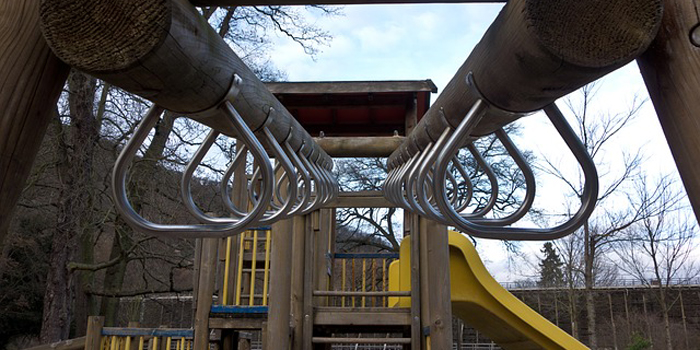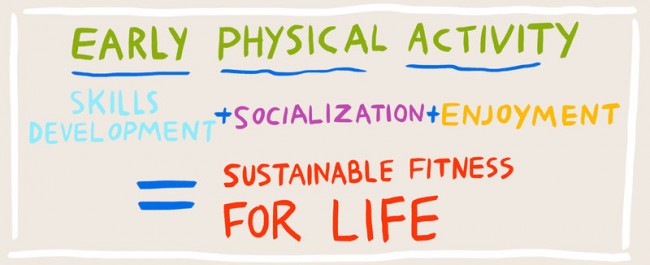
I have had the privilege of hearing Dr. Greg Myer speak on multiple occasions. He is undoubtedly one of my favorite presenters. he is one of the top researchers on ACL injury presention and youth training. If you ever get a chance to see Greg present, don't pass up the opportunity.
NPRs Eric Westerfelt interviewed Greg on the benefits of physical education. His take on the nuerocognitive development, curriculum, and why it is so important for kids to engage in physical activity for lifelong development.
 Gregory D. Myer, PhD, FACSM, CSCS*D
Gregory D. Myer, PhD, FACSM, CSCS*D
- Director of Research, Division of Sports Medicine
- Director of Human Performance Laboratory, Division of Sports Medicine
- Associate Professor, UC Department of Pediatrics
Over the past decade, Dr. Myer has published over 200 articles in peer-reviewed medical journals and has published books and several book chapters related to his research on the biomechanics of knee injury, sports performance and knee injury prevention training.
Dr. Myer has received numerous awards for his excellence in sports medicine research. Among those awards are the American Orthopedic Society of Sports Medicine’s O’Donoghue Sports Injury Research Award (2005, 2015) and The NCAA Research Award (2010), National Strength & Conditioning Association Sports Medicine/Rehabilitation Specialist of the Year (2011), the Association of Bone & Joint Surgeons Nicolas Andry Award (2012), and the George J. Davies - James A. Gould Excellence in Clinical Inquiry Award Excellence in Clinical Inquiry Award (2014). Dr. Myer has been recognized three times by the Clint Thompson Award for Clinical Advancement in Athletic Training (2005, 2010, and 2013). Dr. Myer is currently certified with distinction by the National Strength and Conditioning Association and has been designated as a fellow of the American College of Sports Medicine.
Dr. Myer is serving or has served as an investigator on several nationally funded grants focused on injury prevention and rehabilitation which have contributed multi-million research dollars in direct costs to his institution. He serves as associate/section editor for multiple medical journals and is a member of and lecturer to the American College of Sports Medicine, the National Strength and Conditioning Association, American Orthopaedic Society for Sports Medicine and the National Athletic Training Association. Dr. Myer is also currently serving as the senior research advisor to the Micheli Center for Sports Injury Prevention at Boston Children’s Hospital and represents the United States on the Ireland Sports Surgery Clinic Research Foundation Scientific Advisory Board.
 Learning To Move, Moving To Learn: The Benefits Of PE
Learning To Move, Moving To Learn: The Benefits Of PE
One of our occasional conversations with thought leaders in education.
by Eric Westerfelt, NPR Education Coorespondant
When it comes to kids and exercise, schools need to step up and focus more on quality as well as quantity. And, says Dr. Gregory D. Myer, they need to promote activities that develop motor skills, socialization and fun.
Myer is one of the authors of a recent paper and commentary on children and exercise. He's also director of the Human Performance Lab and director of research at the Division of Sports Medicine at Cincinnati Children's Hospital Medical Center.
Like others, Myer notes that when it's time to trim the budget, PE, art and music classes are often the first to go. While he's certainly distressed by those cuts, he and his co-authors also seek to question the "current dogma that is currently focused on the quantitative rather than qualitative aspects of physical activity" programs for youth.
Myer helped develop exercise guidelines for youth aimed at reducing sports-related injuries and promoting health. The guidelines call for greater focus on short, interval-like bursts of activity interspersed with rest. It includes core strength building, resistance training, agility and more.
School recess time has been cut in many districts. As we've reported, some schools are pushing back on that and others are getting creative to fill the void. According to a 2013 poll NPR conducted in partnership with the Robert Wood Johnson Foundation and the Harvard School of Public Health, 56 percent of parents say their elementary school kids are getting just one or two days of physical education a week.
A lot of parents, including myself, question why PE class isn't every day, or at least a lot more frequent than some schools currently have.
That's partly the emphasis for this paper. We wanted to show that neurocognitive development is associated with exercise and can benefit from exercise. We're really going backwards. Not only are we cutting PE from course work and cutting PE teachers, but there are a lot of schools that are trying to integrate the core courses into all other courses. So if you have PE, they want you to have some writing or mathematics integrated into physical education. We're going all one direction where we are not integrating movements into other classes. I'm telling you, that kid who's been up texting all night and is half asleep, if we made him get up and do five minutes of activity before he sat down at that desk for the next hour, you're probably going to get 15 to 20 more minutes of focused attention out of him. That five minutes is going to be well spent. Let's make this go both ways and get kids active during other classes. Let's give them activities during the day every day. That's where we are really missing the mark.
After school and extracurricular programs have filled some of the gap. But you're saying schools need to step up and do more to integrate more physical activities every day?
Absolutely. These [after-school] programs are all well-meaning and I support them, but not every kid can get there after school and there are resource issues. They don't provide a structure to capture every kid. Our school systems capture almost every kid. That's the system we should capitalize on. This [PE] is not an area we should be cutting.
The U.S. Department of Health and Human Services recommends that kids get at least an hour of physical activity every day that should include some muscle and bone-strengthening. You're not convinced that's nearly enough ?
That's the issue. These guidelines are often derived from adult guidelines. We've looked a lot recently at how aerobic activities work for kids. It's pretty simple if you've worked with or been around kids: When was the last time a kid asked you, 'Hey mom or dad, can I go out and run for two miles?' That's not how they do it. Kids move in short bursts of activity. They like interval-type training, they like muscle-building activities that are fun. That's what we used to do in PE. It used to be gymnastics, movement skills, climb the rope and other gymnastic-based activities. Endurance activities are not successful plans to capture how kids should be moving and playing.
What's your sense of the age in which PE teachers start to see kids lose or gain more interest in gym class?
There's something that happens to a kid when they're 5, 6 and 7 years old. Where in earlier years they don't care if they move more poorly than their peers or look goofy doing something. But there's something around that age where they start to see how they're moving relative to their peers and then there's that divergence. Those kids that have better motor skills continue and often go into sports and other activities that require more complex movements. And those kids that start to move more poorly tend to gravitate toward more non-physical active types of free time.
What do you think is happening there in the 7-year-old psyche that they might start to drift away from physical activities if they see they're not quite as good as Billy or Jane?
It's a critical period in child development. I'm not a psychiatrist or psychologist so I'm probably getting out of my realm. But when they start to look at their peers and their self-perceptions start to be developed, at some time they start to care about how they look in front of their peers. Movement is an area where kids start to diverge in those younger years. And I think it's driven by the lack of skills training they've received. And we can probably keep them relatively equal if we give them the proper training. But it's when they see themselves falling behind [in physical activity], it creates really a vortex of inactivity that feeds on itself.
You want more targeted, purposeful exercises in elementary-age kids. Explain more how you think students should be exercising.
First, it's gotta be fun or they're not gonna do it. Then we have to create some skill-based movements in it and teach them how to do it. It has to be fun and in short bursts. And often they are missing the strength-building exercises. Strength and motor-skills building go hand-in-hand and are often ignored in these guidelines for kids. When I was in physical education we'd spend multiple classes learning how to do a somersault. Then we'd go on to the next maneuver or skill. Is that being done today? Partially. But we are cutting the resources. We don't have enough PE teachers and they don't have enough time with the kids. Often kids are getting it [PE] once a week now. That's unbelievable to me. There's evidence to indicate that the kids who are physically active do better in school.
Childhood obesity rates have stopped climbing, as I understand it, but it's still a huge, huge problem in the U.S.
Correct. While rates have flat-lined they are still at alarming rates. My colleague Dr. (Avery) Faigenbaum likens it to smoking. If you saw a kid smoking a cigarette we would act swiftly to manage that. Yet we have kids who sit down at school all day and then come home and sit in front of their video games and we don't have as much of a problem with that. What we're finding out is the long term consequences of physical inactivity, especially lack of motor skills and conditioning, yet we don't act with the same rigor or vigor with these kids.
What tips do you have for parents? Head to the park with a ball or Frisbee sometimes instead of working on math and reading?
Absolutely. Work on some of these motor skills that are a little more advanced: Kicking, throwing, shooting a basketball. So that their child gets more opportunities when they're not in front of their peers. You show them how it can be fun and create games around it. That's when the child will say, 'Hey this is not so bad,' and they'll start to work on those skills independently. Then they'll go back into the class and it gives them an opportunity to catch up. And I think the parents need to be out there moving as much as the kids. That's probably a different story, but the benefits to the family will be even greater by focusing on the activities of their children.
Read the Original Article Here:
Source: http://www.npr.org
Eric Westerfelt, NPR Education Corespondent
 After nearly a decade as an award-winning Foreign Correspondent with NPR's international desk, Eric Westervelt returned in September 2013 to domestic news with a new national beat covering American education as an Education Correspondent.
After nearly a decade as an award-winning Foreign Correspondent with NPR's international desk, Eric Westervelt returned in September 2013 to domestic news with a new national beat covering American education as an Education Correspondent.
In this role, he covers the news, issues, and trends in classrooms across the country, from pre-K to higher education. He has a strong interest in the multiple ways in which technology is disrupting traditional pedagogy.
Westervelt recently returned from a 2013 John S Knight Journalism Fellowship at Stanford University. The fellowship focused on journalistic innovation, leadership, entrepreneurship and the future of news.








